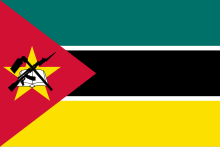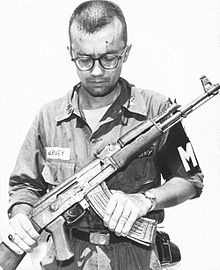The Soviet Union and the People's Republic of China, as well as Western countries (especially the United States) supplied arms and technical knowledge to numerous countries and rebel forces in a global struggle between the Warsaw Pact nations and their allies against NATO and their allies called the Cold War. While the NATO countries used rifles such as the relatively expensive M14, FN FAL, and H&K G3 battle rifles and M16 assault rifle during this time, the low production and materials costs of the AK-47 meant that the Soviet Union could produce and supply its allies at a very low cost. Because of its low cost, it was also duplicated or used as the basis for many other rifles, such as the Israeli Galil, Chinese Type 56, and Swiss SIG SG 550. As a result, the Cold War saw the mass export of AK-47s by the Soviet Union and the PRC to their allies, such as the Nicaraguan Sandinistas, Viet Cong as well as Middle Eastern, Asian, and African revolutionaries. The United States also purchased the Type 56 from the PRC to give to the mujahideen guerrillas during the Soviet war in Afghanistan.

The proliferation of this weapon is reflected by more than just numbers. The AK-47 is included in the flag of Mozambique and its coat of arms, an acknowledgment that the country's leaders gained power in large part through the effective use of their AK-47s. It is also found in the coat of arms of Zimbabwe and East Timor, the revolution era coat of arms of Burkina Faso, the flag of Hezbollah, and the logo of the Iranian Islamic Revolutionary Guards Corps.[citation needed]

In parts of the Western world, the AK-47 is associated with their enemies; both Cold War era and present-day. During the 1980s, the Soviet Union became the principal arms dealer to countries embargoed by Western nations, including Middle Eastern nations such as Syria, Libya and Iran, who welcomed Soviet Union backing against Israel. After the fall of the Soviet Union, AK-47s were sold both openly and on the black market to any group with cash, including drug cartels and dictatorial states, and more recently they have been seen in the hands of violent Islamic terrorist groups such as the Taliban and Al-Qaeda in Afghanistan and Iraq, and FARC, Ejército de Liberación Nacional guerrillas in Colombia. Western movies often portray criminals, gang members and terrorists using AK-47s. For these reasons, in the U.S. and Western Europe the AK-47 is stereotypically regarded as the weapon of choice of insurgents, gangsters and terrorists. Conversely, throughout the developing world, the AK-47 can be positively attributed with revolutionaries or "freedom fighters" against foreign occupation, imperialism, or colonialism.
In Mexico, the AK-47 is known as "Cuerno de Chivo" (literally "Ram's Horn") and is one of the weapons of choice of Mexican drug cartels. It is sometimes mentioned in Mexican folk music lyrics.
In 2006, Colombian musician and peace activist César López devised the escopetarra, an AK converted into a guitar. One sold for US$17,000 in a fundraiser held to benefit the victims of anti-personnel mines, while another was exhibited at the United Nations' Conference on Disarmament.
Kalashnikov Museum
The Kalashnikov Museum (also called the AK-47 museum) opened on November 4, 2004, in Izhevsk, a city in the Ural Mountains of Russia. The museum chronicles the biography of General Kalashnikov, as well as documents the invention of the AK-47. The museum complex of small arms of M. T. Kalashnikov, a series of halls and multimedia exhibitions is devoted to the evolution of the AK-47 assault rifle and attracts 10,000 monthly visitors. The museum serves as Russia's monument to this world-renowned infantry weapon.
Nadezhda Vechtomova, the museum director stated in an interview that the purpose of the museum is to honor the ingenuity of the inventor and the hard work of the employees and to "separate the weapon as a weapon of murder from the people who are producing it and to tell its history in our country."